美国文学名词解释
美国文学名词解释
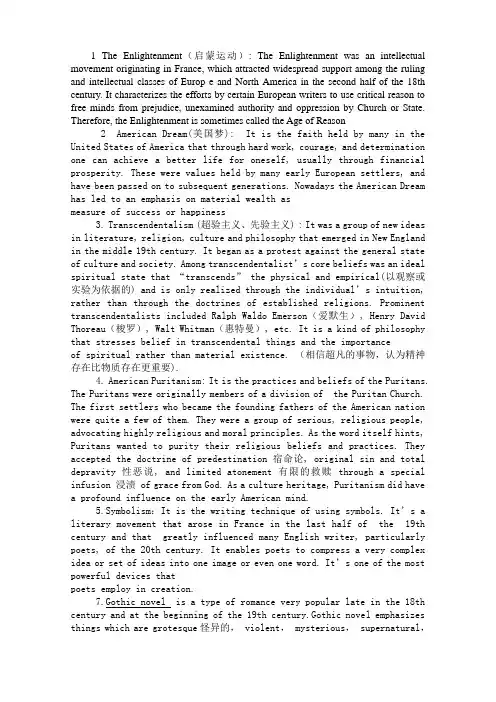
1 The Enlightenment(启蒙运动): The Enlightenment was an intellectual movement originating in France, which attracted widespread support among the ruling and intellectual classes of Europ e and North America in the second half of the 18th century. It characterizes the efforts by certain European writers to use critical reason to free minds from prejudice, unexamined authority and oppression by Church or State. Therefore, the Enlightenment is sometimes called the Age of Reason2 American Dream(美国梦): It is the faith held by many in the United States of America that through hard work, courage, and determination one can achieve a better life for oneself, usually through financial prosperity. These were values held by many early European settlers, and have been passed on to subsequent generations. Nowadays the American Dream has led to an emphasis on material wealth asmeasure of success or happiness3. Transcendentalism (超验主义、先验主义) : It was a group of new ideas in literature, religion, culture and philosophy that emerged in New England in the middle 19th century. It began as a protest against the general state of culture and society. Among transcendentalist’s core beliefs was an ideal spiritual state that “transcends” the physical and empirical(以观察或实验为依据的) and is only realized through the individual’s intuition, rather than through the doctrines of established religions. Prominent transcendentalists included Ralph Waldo Emerson(爱默生), Henry David Thoreau(梭罗), Walt Whitman(惠特曼), etc. It is a kind of philosophy that stresses belief in transcendental things and the importanceof spiritual rather than material existence. (相信超凡的事物,认为精神存在比物质存在更重要).4. American Puritanism: It is the practices and beliefs of the Puritans. The Puritans were originally members of a division of the Puritan Church. The first settlers who became the founding fathers of the American nation were quite a few of them. They were a group of serious, religious people, advocating highly religious and moral principles. As the word itself hints, Puritans wanted to purity their religious beliefs and practices. They accepted the doctrine of predestination宿命论, original sin and total depravity性恶说, and limited atonement 有限的救赎 through a special infusion 浸渍 of grace from God. As a culture heritage, Puritanism did havea profound influence on the early American mind.5.Symbolism:It is the writing technique of using symbols. It’s a literary movement that arose in France in the last half of the 19th century and that greatly influenced many English writer, particularly poets, of the 20th century. It enables poets to compress a very complex idea or set of ideas into one image or even one word. It’s one of the most powerful devices thatpoets employ in creation.7.Gothic novel is a type of romance very popular late in the 18th century and at the beginning of the 19th century.Gothic novel emphasizes things which are grotesque怪异的, violent, mysterious, supernatural,desolate 荒凉 and horrifying. Gothic, originally in the sense of“medic医学,not classical”,with its descriptions of the dark,irrational side of human nature,Gothic novel has exerted a great influence over the writers of the Romantic period.8 Imagism: it’s a poetic movement of England and the U.S flourished from 1909 to 1917. The movement insists on the creation of images in poetry by “the direct treatment of the thing” and the economy of wording. The leaders of this movement were Ezra Pound and Amy Lowell艾米•洛威尔.8. Imagism: It came into being in Britain and U.S around 1910 as a reaction to the traditional English poetry to express the sense of fragmentation and dislocation. The imagists, with Ezra Pound leading the way, hold that the most effective means to express these momentary impressions is through the use of one dominant image. Imagism is characterized by the following three poetic principles: direct treatment of subject matter; economy of expression; as regards rhythm, to compose in the sequence of the musical phrase, not in the sequence of metronome 节拍器. Pound’s “In a Station of the Metro” is a well-known imagist poem.9. Stream of Consciousness(意识流): It is a style used in the presentation of the character’s inner working of mind. The assumption is that an individual’s psychological processes are a continuous flow like a shifting, uninterrupted stream, highly changeable and confusing, often appearing illogical and contrary to reason. In tracing the stream of consciousness of an individual the writer may present interior monologue(内心独白) by his character, hint with symbols, reverse(颠倒) the order of time, and alternate(轮流的/交替的) recollections(回忆) with the present or sometime illusions(幻想) with given facts.10. Point of view( 视角):It is a term referring to the vantage point (能观察某事物的有利位置) or position from which a story is told. To identify(识别) the narrator of a story is to identify the story’s point of view. Basically there are two narrative ways: first-person point of view and the third-personpoint of view.12. The Harlem Renaissance: it was the first important movement in black American literature. Immediately after the First World War, as a result of a massive black migration to Northern cities, a group of young, talented black artists congregated in Harlem, a predominantly black section of New York City, and made it the cultural, and intellectual capital of black America. They carried forward the cultural traditions of their people and demonstrated their achievements to the white society that habitually ignored them.13. Expressionism 表现主义: it arouse in German theater after World War I. Delighting in bizarre (奇异的) stage design and exaggerated makeup and costuming(服装), expressionists sought to reflect intense states of emotion. Its mode is “the externalization(外表性) of t he inner.”14.Black humor: It is a combination of humor with resentment(怨恨), gloom, anger, and despair. Seeing all that is unreasonable, hypocritical,ugly, and even frenzied(狂乱的),writers of black humor nurse a grievance(不平) against their society which, according to them, is full of institutionalized(制度化的) absurdity. Yet they are cynical. They laugh a morbid(病态的) laugh when facing the hideous(丑恶的). In hopeless indignation(愤慨) they take up freezing irony and burning satire as their weapons. Their novels are often in the form of anti-novel(反传统小说), devoid of(缺乏) completeness of plot and characterized by fragmentation (零碎的) and dislocation(混乱).(专业文档资料素材和资料部分来自网络,供参考。
美国文学术语解释(全面且简练)
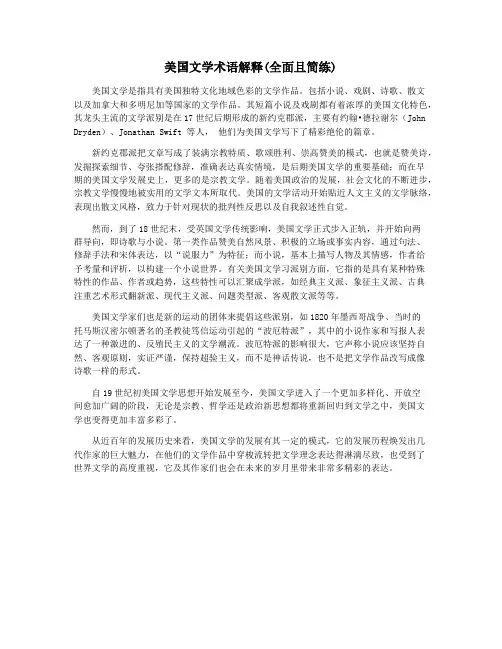
美国文学术语解释(全面且简练)美国文学是指具有美国独特文化地域色彩的文学作品。
包括小说、戏剧、诗歌、散文以及加拿大和多明尼加等国家的文学作品。
其短篇小说及戏剧都有着浓厚的美国文化特色,其龙头主流的文学派别是在17世纪后期形成的新约克郡派,主要有约翰•德拉谢尔(John Dryden)、Jonathan Swift 等人,他们为美国文学写下了精彩绝伦的篇章。
新约克郡派把文章写成了装满宗教特质、歌颂胜利、崇高赞美的模式,也就是赞美诗,发掘探索细节、夸张搭配修辞,准确表达真实情境,是后期美国文学的重要基础;而在早期的美国文学发展史上,更多的是宗教文学。
随着美国政治的发展,社会文化的不断进步,宗教文学慢慢地被实用的文学文本所取代。
美国的文学活动开始贴近人文主义的文学脉络,表现出散文风格,致力于针对现状的批判性反思以及自我叙述性自觉。
然而,到了18世纪末,受英国文学传统影响,美国文学正式步入正轨,并开始向两群导向,即诗歌与小说。
第一类作品赞美自然风景、积极的立场或事实内容,通过句法、修辞手法和宋体表达,以“说服力”为特征;而小说,基本上描写人物及其情感,作者给予考量和评析,以构建一个小说世界。
有关美国文学习派别方面,它指的是具有某种特殊特性的作品、作者或趋势,这些特性可以汇聚成学派,如经典主义派、象征主义派、古典注重艺术形式翻新派、现代主义派、问题类型派、客观散文派等等。
美国文学家们也是新的运动的团体来提倡这些派别,如1820年墨西哥战争、当时的托马斯汉密尔顿著名的圣教徒笃信运动引起的“波厄特派”,其中的小说作家和写报人表达了一种激进的、反殖民主义的文学潮流。
波厄特派的影响很大,它声称小说应该坚持自然、客观原则,实证严谨,保持超验主义,而不是神话传说,也不是把文学作品改写成像诗歌一样的形式。
自19世纪初美国文学思想开始发展至今,美国文学进入了一个更加多样化、开放空间愈加广阔的阶段,无论是宗教、哲学还是政治新思想都将重新回归到文学之中,美国文学也变得更加丰富多彩了。
美国文学名词解释
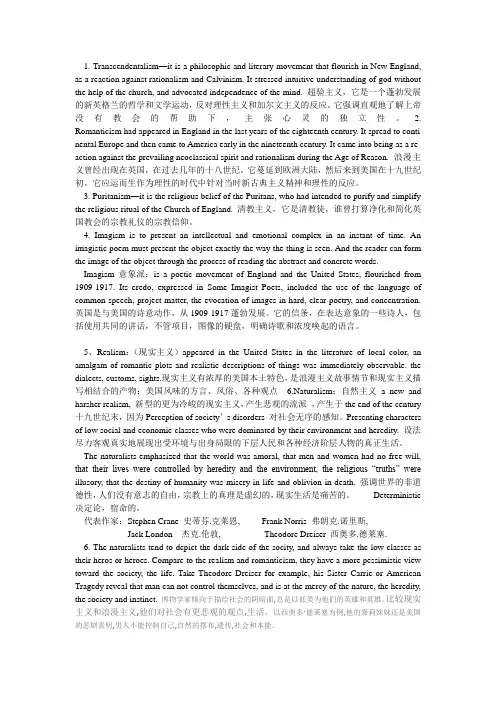
1. Transcendentalism—it is a philosophic and literary movement that flourish in New England, as a reaction against rationalism and Calvinism. It stressed intuitive understanding of god without the help of the church, and advocated independence of the mind. 超验主义,它是一个蓬勃发展的新英格兰的哲学和文学运动,反对理性主义和加尔文主义的反应。
它强调直观地了解上帝没有教会的帮助下,主张心灵的独立性。
2. Romanticism had appeared in England in the last years of the eighteenth century. It spread to conti nental Europe and then came to America early in the nineteenth century. It came into being as a re action against the prevailing neoclassical spirit and rationalism during the Age of Reason. 浪漫主义曾经出现在英国,在过去几年的十八世纪。
它蔓延到欧洲大陆,然后来到美国在十九世纪初。
它应运而生作为理性的时代中针对当时新古典主义精神和理性的反应。
3. Puritanism—it is the religious belief of the Puritans, who had intended to purify and simplify the religious ritual of the Church of England. 清教主义,它是清教徒,谁曾打算净化和简化英国教会的宗教礼仪的宗教信仰。
美国文学名词解释完整版
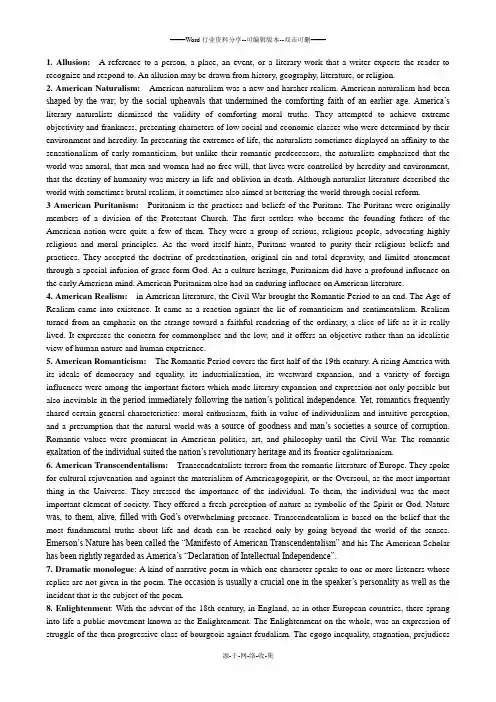
7. Dramatic monologue: A kind of narrative poem in which one character speaks to one or more listeners whose replies are not given in the poem. The occasion is usually a crucial one in the speaker’s personality as well as the incident that is the subject of the poem.
6. American Transcendentalism:Transcendentalists terrors from the romantic literature of Europe. They spoke for cultural rejuvenation and against the materialism of Americagogopirit, or the Oversoul, as the most important thing in the Universe. They stressed the importance of the individual. To them, the individual was the most important element of society. They offered a fresh perception of nature as symbolic of the Spirit or God. Nature was, to them, alive, filled with God’s overwhelming presence. Transcendentalism is based on the belief that the most fundamental truths about life and death can be reached only by going beyond the world of the senses. Emerson’s Nature has been called the “Manifesto of American Transcendentalism” and his The American Scholar has been rightly regarded as America’s “Declaration of Intellectual Independence”.
美国文学名词解释
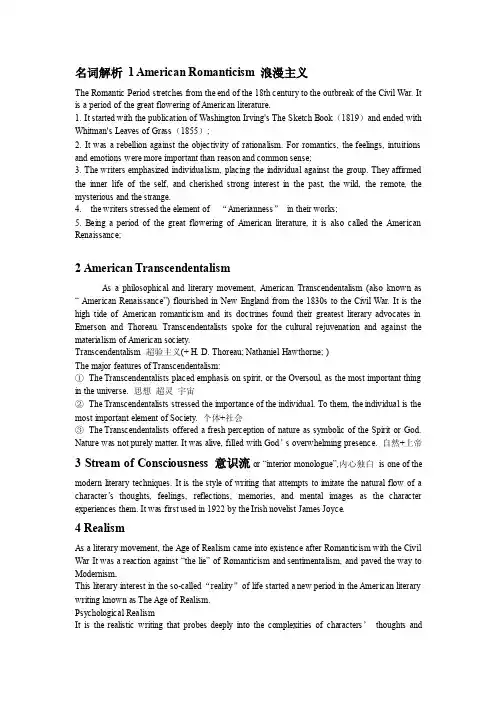
名词解析1 American Romanticism 浪漫主义The Romantic Period stretches from the end of the 18th century to the outbreak of the Civil War. It is a period of the great flowering of American literature.1. It started with the publication of Washington Irving's The Sketch Book(1819)and ended with Whitman's Leaves of Grass(1855);2. It was a rebellion against the objectivity of rationalism. For romantics, the feelings, intuitions and emotions were more important than reason and common sense;3. The writers emphasized individualism, placing the individual against the group. They affirmed the inner life of the self, and cherished strong interest in the past, the wild, the remote, the mysterious and the strange.4. the writers stressed the element of “Amerianness”in their works;5. Being a period of the great flowering of American literature, it is also called the American Renaissance;2 American TranscendentalismAs a philosophical and literary movement, American Transcendentalism (also known as “ American Renaissance”) flourished in New England from the 1830s to the Civil War. It is the high tide of American romanticism and its doctrines found their greatest literary advocates in Emerson and Thoreau. Transcendentalists spoke for the cultural rejuvenation and against the materialism of American society.Transcendentalism 超验主义(+ H. D. Thoreau; Nathaniel Hawthorne; )The major features of Transcendentalism:①The Transcendentalists placed emphasis on spirit, or the Oversoul, as the most important thing in the universe. 思想超灵宇宙②The Transcendentalists stressed the importance of the individual. To them, the individual is the most important element of Society. 个体+社会③The Transcendentalists offered a fresh perception of nature as symbolic of the Spirit or God. Nature was not purely matter. It was alive, filled with God’s overwhelming presence. 自然+上帝3 Stream of Consciousness 意识流or “interior monologue”,内心独白is one of themodern literary techniques. It is the style of writing that attempts to imitate the natural flow of a character’s thoughts, feelings, reflections, memories, and mental images as the character experiences them. It was first used in 1922 by the Irish novelist James Joyce.4 RealismAs a literary movement, the Age of Realism came into existence after Romanticism with the Civil War It was a reaction against “the lie” of Romanticism and sentimentalism, and paved the way to Modernism.This literary interest in the so-called “reality”of life started a new period in the American literary writing known as The Age of Realism.Psychological RealismIt is the realistic writing that probes deeply into the complexities of characters’thoughts andmotivations. And Henry James is considered the founder of psychological realism. He believed that reality lies in the impressions made by life on the spectator, and not in any facts of which the spectator is unaware. Such realism is therefore merely the obligation that the artist assumes to represent life as he sees it.The three dominant figures of the period are William Dean Howells豪威尔斯, Mark Twain, and Henry James. Mark Twain and Howells seemed to have paid more attention to the “life” of the Americans, and Henry James had apparently laid greater emphasis on the “inner world”of man.5 Puritanismwas a religious reform movement that arose within the Church of England in the late sixteenth century. Under siege from church and crown, it sent an offshoot in the third and fourth decades of the seventeenth century to the northern English colonies in the New World--a migration that laid the foundation for the religious, intellectual, and social order of New England. Puritanism, however, was not only a historically specific phenomenon coincident with the founding of New England; it was also a way of being in the world--a style of response to lived experience--that has reverberated through American life ever since.6 American NaturalismAs a literary movement, naturalism grew out of the 19th century realism, the evolutionary theory in his “The Origin of Species”----“the fittest, the survival”in biological sphereThree major concepts of literary naturalism:1) Humans are controlled by laws of heredity and environment.2) The universe is cold, godless, indifferent and hostile to human desires.3) The naturalists think that the true reality is not found in the smiling aspects of middle class life, but in the dominant forces of Nature in stopping human desires, in keeping humans from accomplishing their dreams.They offered vivid pictures of the lives of the down-trodden and the abnormal7 Code HeroGeneral Features:1.He has great physical potential and courage.2. The “code heroes ”have strong willpower.3. Thirdly , another important feature of the “code heroes" is their loyalty.4. Fourthly , the" code heroes ”maintain great dignity in all situations.5. Fifthly , the “code heroes ”are endowed with certain specialized skills , such as fishing , bull fighting , and hunting , etc6, the “code heroes ”are always put in some touch-and go situations, what the heroes must always face up to is their own personal fear of death and the threat of destruction, and it is this obstacle, death, that they have to overcome.8 Local colorismIn literature, local color fiction refers to fiction or poetry that focuses on specific features –including characters, dialects, customs, history, and landscape –of a particular region.Local colorism as a trend first made its presence felt in the late 1860s and early 1870s. It did notcease to be a dominant fashion until the turn of the 20th century. It formed an important part of the realistic movement.Local colorism founds its own position in national literature by its own localism; at the same time, national literature improves its own status by local colorism. It is with local colorism American literature comes to mature and can compete with European one,after that,American Literature becomes really American one.。
美国文学名词解释
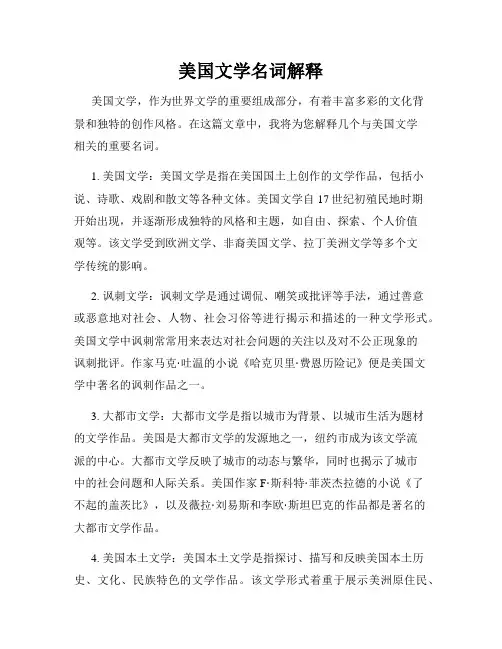
美国文学名词解释美国文学,作为世界文学的重要组成部分,有着丰富多彩的文化背景和独特的创作风格。
在这篇文章中,我将为您解释几个与美国文学相关的重要名词。
1. 美国文学:美国文学是指在美国国土上创作的文学作品,包括小说、诗歌、戏剧和散文等各种文体。
美国文学自17世纪初殖民地时期开始出现,并逐渐形成独特的风格和主题,如自由、探索、个人价值观等。
该文学受到欧洲文学、非裔美国文学、拉丁美洲文学等多个文学传统的影响。
2. 讽刺文学:讽刺文学是通过调侃、嘲笑或批评等手法,通过善意或恶意地对社会、人物、社会习俗等进行揭示和描述的一种文学形式。
美国文学中讽刺常常用来表达对社会问题的关注以及对不公正现象的讽刺批评。
作家马克·吐温的小说《哈克贝里·费恩历险记》便是美国文学中著名的讽刺作品之一。
3. 大都市文学:大都市文学是指以城市为背景、以城市生活为题材的文学作品。
美国是大都市文学的发源地之一,纽约市成为该文学流派的中心。
大都市文学反映了城市的动态与繁华,同时也揭示了城市中的社会问题和人际关系。
美国作家F·斯科特·菲茨杰拉德的小说《了不起的盖茨比》,以及薇拉·刘易斯和李欧·斯坦巴克的作品都是著名的大都市文学作品。
4. 美国本土文学:美国本土文学是指探讨、描写和反映美国本土历史、文化、民族特色的文学作品。
该文学形式着重于展示美洲原住民、欧洲移民、非裔美国人和其他少数族裔的文化传统和经验。
美国作家奥兰多·费斯特的小说《渐近线》以及路易斯·埃里斯的小说《米南多洛之歌》都是美国本土文学的代表作品。
5. 后现代主义文学:后现代主义文学是指具有反传统、颠覆常规、模糊现实与虚幻界限的文学形式。
在晚20世纪以后的美国文学中,后现代主义作品开始兴起。
该文学形式常常使用非线性叙事、多重视角和流派的混合等技巧来表达个体性、主观性和相对主义等概念。
美国作家托马斯·品钦的小说《地下时光》以及大卫·福斯特·华莱士的小说《无人生还》都是后现代主义文学的代表作品。
美国文学术语解释
美国文学术语解释美国文学术语解释American puritanism(美国清教主义)Colonial American(殖民时期的美国)Great Aweaking(宗教大觉醒运动)American Romanticism(美国浪漫主义)Gothic tradition(哥特传统) Historical novel(历史小说)Civil War(美国内战)Transcendentalism(超验主义) Individualism(个人主义) Unitarianism(上帝一位论) Allegory(寓言) American Renaissance(美国文艺复兴)Original Sin(原罪)American Enlightenment(美国启蒙运动)Free verse(自由诗) Alliteration(头韵) Assonance(类韵) Consonance(和音)Lyric(抒情诗)Sonnet(十四行诗)Point of view(视角)Realism(现实主义)Local Colorism(地方特色主义) Irony(反讽)Naturalism(自然主义)Social Darwinism(社会达尔文主义)Dadaism(达尔文主义) Expressionism(表现主义) Harlem Renaissance(哈姆雷特文艺复兴)Imagism(意象主义)Jazz Age(爵士乐时代) Surrealism(超现实主义)V orticism(漩涡派)Dramatic Monologue(戏剧性独白)Lost Generation(迷惘的一代) Metaphysical poets(玄学派诗人)Narrator(叙述者)Stream of Consciousness(意识流) The Beat Generation(垮掉的一代) The 1930s(美国30年代)New Criticism(新批评主义) Theatre of the Absurd(荒诞剧) Postmodernism(后现代主义) Metafiction(元小说) Confessional poetry(自白派诗歌) The New York School(纽约派诗人)The absurd(荒谬派)Parody(戏讽)Magic realism(魔幻现实主义) The National Association for the Advancement of ColoredPeople(NAACP)(美国有色人种协进会)The Native American Renaissance(土著美国人文艺复兴)。
美国文学文学名词解释
1 Modernism(现代主义)Modernism is comprehensive but vague term for a movement , which begin in the late19th century and which has had a wide influence internationally during much of the 20th century、2> modernism takes the irrational philosophy and the theory of psycho-analysis as its theoretical case、3> the term pertains to all the creative arts、Especially poetry, fiction, drama, painting, music and architecture、现代主义就是全面但运动模糊的术语,在19世纪末期开始,在国际上有广泛影响的在20世纪的大部分时间。
2 >现代主义以非理性哲学与精神分析理论为其理论的情况。
3 >这个词属于所有的创造性艺术。
特别就是诗歌、小说、戏剧、绘画、音乐与建筑。
2 Transcendentalism(超验主义)Transcendentalism is literature, philosophical and literary movement that flourished in new England from about 1836 to 1860、it is the summit of American Romanticism、it originated among a small group of intellectuals who were reacting against the orthodoxy of Calvinism and the rationalism of the Unitarian Church, developing instead their own faith centering on the divinity of humanity and the natural world、Transcendentalism derived some of its basic idealistic concepts from romantic German philosophy, and from such English authors as Coleridge and Wordsworth、Its mystical aspects were partly influenced by Indian and Chinese religious teachings、Although Transcendentalism was never a rigorously systematic philosophy, it had some basic tenets that were generally shared by its adherents、The beliefs that God is immanent in each person and in nature and that individual intuition is the highest source of knowledge led to an optimistic emphasis on individualism, self-reliance, and rejection of traditional authority、The ideas of Transcendentalism were most eloquently expressed by Ralph waldo Emerson in such essays as Nature, and by Henry David Thoreau in his book Walden、超验主义就是从1836至1860于新英格兰发起的一场文学,哲学以及艺术运动。
美国文学名词解释
(一)About Puritanism清教主义1.“would-be purifier”They wanted to purify the English Church and to restore church worship to the “pure and unspotted”condition of its earlier days .They opposed the elaborate rituals of the English Church. They believed that the Bible was the revealed word of God, therefore, people should guide their daily behavior with the Bible.2.Basic Puritan Beliefs(1)Total Depravity - through Adam's fall, every human is born sinful - concept of Original Sin.(2)Unconditional Election - God "saves" those he wishes - only a few are selected for salvation - concept of predestination(3)Limited Atonement - Jesus died for the chosen only, not for everyone.(4)Irresistible Grace - God's grace is freely given, it cannot be earned or denied. Grace is defined as the saving and transfiguring power of God.(5)Perseverance of the "saints" - those elected by God have full power to interpret the will of God, and to live uprightly. If anyone rejects grace after feeling its power in his life, he will be going against the will of God - something impossible in Puritanism.2.The impact of Puritanism (1)High standards of moral excellence and conscience ;(2) Emphasis on education(3)Hard working, thrifty, independent spirit;(4)“Chosen people”consciousness .(诺斯替教)(二)Enlightenment(启蒙运动)Enlightenment is man’s leaving his self-caused immaturity.Immaturity is the incapacity to use one's intelligence without the guidance of another.@A term used to describe the trends in thought and letters in Europe and the American colonies during the 18th century prior to the French Revolution. The precursors of the Enlightenment can be traced to the 17th century and earlier.@The phrase was frequently employed by writers of the period itself, convinced that they were emerging from centuries of darkness and ignorance into a new age enlightened by reason, science, and a respect for humanity.(三)Romanticism (浪漫主义)As an approach in literary creation, romanticism is ever present in literature of all times. But as a literary trend or movement, it occurred and developed in Europe and America at the turn of the 18th and 19th centuries under the historical background of the Industrial Revolution around 1760 and the French Revolution (1789-1799). @ A movement in the literature of virtually every country of Europe, the United States, and Latin America that lasted from about 1750 to about 1870,@It was characterized by reliance on the imagination and subjectivity, freedom of thought and expression, and an idealization of nature.(四)Transcendentalism(超验主义)Transcendentalism is the summit of the Romantic Movement in theU.S. in the first half of the 19th century. It asserts the existence of an ideal spiritual reality that transcends the empirical and scientific and is knowable through intuition .Transcendentalists place emphasis on the importance of the Over-soul, the individual and Nature. It was, in essence, romantic idealism on Puritan soil.(五)Free versepoetry without a fixed beat or regular rhyme scheme.(六)Blank verse“Blank verse” is poetry written in regular metrical but unrhymed lines, almost always iambic pentameters.(七)American Realism (1865—1918)(现实主义)American Realism came in the latter half of the nineteenth century as a reaction against Romanticism. It stresses truthful treatment of material. It focuses on commonness of the lives of the common people, and emphasizes objectivity and offers an objective rather than an idealistic view of human nature and human experience. The three dominant figures of the period are William Howells, Mark Twain, and Henry James.(八)Definition of Local Color(乡土特色)1.Literature that focuses on the characters, dialect, customs, topography(地形), and other features particular to a specific region that exploits the speech, dress, mannerisms, and habits of thatspecific region .2.Twain’s Local colorismTwain preferred to present social life through portraits of the local characters of his regions, including people living in that area, the landscape, and other peculiarities like the customs, dialects, costumes and so on. So the rich material of his boyhood experience on the Mississippi became endless resources for his fiction, and the Mississippi valley and the west became his major theme.(九)American Naturalism (1890s-1910s) (自然主义)1.Historical Background:—The spread of industrialization created extremes of wealth and poverty. —Farmers were still going westward, but frontiers were about the close. They had to depend on the transcontinental railway to transport their products.—The spread of Darwin’s theory of evolution changed people’s ideology.2. Thematically, naturalistic writers:-- wrote detailed descriptions of the lives of the downtrodden and of the abnormal-- had frank treatment of human passion and sexualit-- were concerned about how men and women were overwhelmed by the forces of environment and by the forces of heredity-- made detailed documentation of life: nothing but the truth, more naked and wicked than realism-- created gloomy and pessimistic atmosphere3. Here are the major features of naturalism.Humans are controlled by laws of heredity and environment.The universe is cold, godless, indifferent and hostile to human desires. @Naturalistic writers are pessimistic. They choose their subjects from the lower.(10)Modernism(现代主义)(1)appeared after World War I(2)cutting off history and a sense of despair and loss(3)refusing to accept the traditional concept of value and all traditional ideological influences.1. BackgroundIn the first world war, America got considerable benefits with animal cost, but many artist and thinkers with suffering consciousness felt the terribleness of modern wars.Their heroism in mind gradually disappeared. Some of them going into battle suffered the sight of blood and all kinds of disasters. After back to America, they found that the social reality had experienced great change.2.Features or changes of the period(1)Increasing industrialization (2)Deepening urbanization(3)High speed development of technology and science(4 )Trauma of the first world war(5)1930s economic depression(6)Collapse of social value system(7)Dropping moral standards(8)Common depression , fear ,sense of loss3. Features of the worksFreud’s psychoanalysis ,William James stream of consciousnesstheory and archetypal symbol had great impact on the writers of modern American writers. They pay special attention to the inner world of the people, during this period ,the most compelling literature movement is the writer’s self exile, also known as the second American renaissance .(十一)Novelists ——the Lost Generation“迷惘的一代”(1920s) The novelists who produced a literature of disillusionment in the aftermath of World War I, and some of them lived abroad:(1)Used their wartime experience as the basis for their works (2)were cut off from old values yet unable to come to terms with the new era(3)wondered pointlessly and restlessly(4)were frustrated by the war(5)spokesman ——Hemingway(十二)The Jazz AgeThe Jazz Age is the nickname in America of the decade of the 1920’s, beginning from 1919 to the Crash at the end of 1929.These ten years were, for Americans, a time of carefree prosperity, isolated from the world’s problem, bewildering great social change, and a feverish pursuit of pleasure.These were the ten years when the First World War was just over, when new inventions and manufacturing techniques greatly changed the way people lived; when people moved from the countryside in great numbers; when women won the right to vote and many started to earn their own money; when cars,washing machines,radios and vacuum cleaners became commonplace; and when millions of people lived beyond their means and went into debt in order to obtain such things while the middle class frantically pursued individual “success”and personal enjoyment. They lived a rich, extravagant, frivolous moneymaking life, and it was this style of living gave the decade of the 1920’s such nickname as the “Jazz Age”, the “Dollar Decade”, and the “Roaring Twenties.”(十三)Imagism(1900S-1910S)(意象派)The Imagist movement included English and American poets in the early twentieth century who wrote free verse and were devoted to "clarity of expression through the use of precise visual images." The Imagist Movement began in London and later spread to the US. It underwent three major phases in its development.(十四)IronyA contrast or discrepancy between what is said and what is meant or between what happens and what is expected to happen in life and in literature.。
美国文学术语解释
01. Humanism(人文主义)Humanism is the essence of the Renaissance.2> it emphasizes the dignity of human beings and the importance of the present life. Humanists voiced their beliefs that man was the center of the universe and man did not only have the right to enjoy the beauty of the present life, but had the ability to perfect himself and to perform wonders.02. Renaissance(文艺复兴)The word “Renaissance”means “rebirth”, it meant the reintroduction into westerm Europe of the full cultural heritage of Greece and Rome.2>the essence of the Renaissance is Humanism. Attitudes and feelings which had been characteristic of the 14th and 15th centuries persisted well down into the era of Humanism and reformation.3> the real mainstream of the english Renaissance is the Elizabethan drama with william shakespeare being the leading dramatist.03. Metaphysical poetry(玄学派诗歌)Metaphysical poetry is commonly used to name the work of the 17th century writers who wrote under the influence of John Donne.2>with a rebellious spirit, the Metaphysical poets tried to break away from the conventional fashion of the Elizabethan love poetry.3>the diction is simple as compared with that of the Elizabethan or the Neoclassical periods, and echoes the words and cadences of common speech.4>the imagery is drawn from actual life.04. Classcism(古典主义)Classcism refers to a movement or tendency in art, literature, or music that reflects the principles manifested in the art of ancient Greece and Rome. Classicism emphasizes the traditional and the universal, and places value on reason, clarity, balance, and order. Classicism, with its concern for reason and universal themes, is traditionally opposed to Romanticism, which is concerned with emotions and personal themes.05. Enlightenment(启蒙运动)Enlightenment movement was a progressive philosophical and artistic movement which flourished in france and swept through western Europe in the 18th century.2> the movement was a furtherance of the Renaissance from 14th century to the mid-17th century.3>its purpose was to enlighten the whole world with the light of modern philosophical and artistic ideas.4>it celebrated reason or rationality, equality and science. It advocated universal education.5>famous among the great enlighteners in england were those great writers like Alexander pope. Jonathan swift.etc.06.Neoclassicism(新古典主义)In the field of literature, the enlightenment movement brought about a revival of interest in the old classical works.2>this tendency is known as neoclassicism. The Neoclassicists held that forms of literature were to be modeled after the classical works of the ancient Greek and Roman writers such as Homer and Virgil and those of the contemporary French ones.3> they believed that the artistic ideals should be order, logic, restrained emotion and accuracy, and that literature should be judged in terms of its service to humanity.07. The Graveyard School(墓地派诗歌)The Graveyard School refers to a school of poets of the 18th century whose poems are mostly devoted to a sentimental lamentation or meditation on life. Past and present, with death and graveyard as themes.2>Thomas Gray is considered to be the leading figure of this school and his Elegy written in a country churchyard is its most representative work.08. Romanticism(浪漫主义)1>In the mid-18th century, a new literary movement called romanticism came to Europe and then to England.2>It was characterized by a strong protest against the bondage of neoclassicism, which emphasized reason, order and elegant wit. Instead, romanticism gave primary concern to passion, emotion, and natural beauty.3>In the history of literature. Romanticism is generally regarded as the thought that designates a literary and philosophical theory which tends to see the individual as the very center of all life and experience. 4> The English romantic period is an age of poetry which prevailed in England from 1798 to 1837. The major romantic poets include Wordsworth, Byron and Shelley.09. Byronic Hero(拜伦式英雄)Byronic hero refers to a proud, mysterious rebel figure of noble origin.2> with immense superiority in his passions and powers, this Byronic Hero would carry on his shoulders the burden of righting all the wrongs in a corrupt society. And would rise single-handedly against any kind of tyrannical rules either in government, in religion, or in moral principles with unconquerable wills and inexhaustible energies.3> Byron’s chief contr ibution to English literature is his creation of the “Byronic Hero”10. Critical Realism(批判现实主义)Critical Realism is a term applied to the realistic fiction in the late 19th and early 20th centuries.2> It means the tendency of writers and intellectuals in the period between 1875 and 1920 to apply the methods of realistic fiction to the criticism of society and the examination of social issues.3> Realist writers were all concerned about the fate of the common people and described what was faithful to reality.4> Charles Dickens is the most important critical realist.11. Aestheticism(美学主义)The basic theory of the Aesthetic movement--- “art for art’s sake” was set forth by a French poet, Theophile Gautier, the first Englishman who wrote about the theory of aestheticism was Walter Pater.2> aestheticism places art above life, and holds that life should imitate art, not art imitate life.3> According to the aesthetes, all artistic creation is absolutely subjective as opposed to objective. Art should be free from any influence of egoism. Only when art is for art’s sake, can it be immortal. They believed that art should be unconcerned with controversial issues, such as politics and morality, and that it should be restricted to contributing beauty in a highly polished style.4> This is one of the reactions against the materialism and commercialism of the Victorian industrial era, as well as a reaction against the Victorian convention of art for morality’s sake, or art for money’s sake.美学运动的基本原则”为艺术而艺术”最初由法国诗人西奥费尔.高缔尔提出,英国运用该美学理论的第一人是沃尔特.佩特.美学主义崇尚艺术高于生活,认为生活应模仿艺术,而不是艺术模仿生活.在美学主义看来,所有的艺术创作都是绝对主观而非客观的产物.艺术不应受任何功利的影响,只有当艺术为艺术而创作时,艺术才能成为不朽之作.他们还认为艺术不应只关注一些热点话题如政治和道德问题,艺术应着力于以华丽的风格张扬美.这是对维多利亚工业发展时期物质崇拜的一种回应,也是向艺术为道德或为金钱而服务的维多利亚传统的挑战.12.The Victorian period(维多利亚时期)In this period, the novel became the most widely read and the most vital and challenging expression of progressive thought. While sticking to the principle of faithful representation of the 18th century realist novel, novelists in this period carried their duty forward to criticism of the society and the defense of the mass.2> although writing from different points of view and with different techniques, they shared one thing in common, that is, they were all concerned about the fate of the common people. They were angry with the inhuman social institutions, the decaying social morality as represented by the money-worship and Utilitarianism, and the widespread misery, poverty and injustice.3>their truthful picture of people’s life and bitter and strong criticism of the society had done much in awakening the public consciousness to the social problems and in the actual improvement of the society.4> Charles Dickens is the leading figure of the Victorian period.13. Modernism(现代主义)Modernism is comprehensive but vague term for a movement , which begin in the late 19th century and which has had a wide influence internationally during much of the 20th century.2> modernism takes the irrational philosophy and the theory ofpsycho-analysis as its theoretical case.3> the term pertains to all the creative arts. Especially poetry, fiction, drama, painting, music and architecture.4> in England from early in the 20th century and during the 1920s and 1930s, in America from shortly before the first world war and on during the inter-war period, modernist tendencies were at their most active and fruitful.5>as far as literature is concerned, Modernism reveals a breaking away from established rules, traditions and conventions. fresh ways of looking at man’s position and function in the universe and many experiments in form and style. It is particularly concerned with language and how to use it and with writing itself.14. Stream of consciousness(意识流)(or interior monologue)In literary criticism, Stream of consciousness denotes a literary technique which seeks to describe an individual’s point of view by giving the written equivalent of the character’s thought processes. Stream of consciousness writing is strongly associated with the modernist movement. Its introduction in the literary context, transferred from psychology, is attributed to May Sinclair. Stream of consciousness writing is usually regarded as a special form of interior monologue and is characterized by associative leaps in syntax and punctuation that can make the prose difficult to follow, tracing as they do a character’s fragmentary thoughts and sensory feelings. Famous writers to employ this technique in the English language include James Joyce and William Faulkner.学术界认为意识流是一种通过直接描述人物思维过程来寻求个人视角的文学写作技巧。
- 1、下载文档前请自行甄别文档内容的完整性,平台不提供额外的编辑、内容补充、找答案等附加服务。
- 2、"仅部分预览"的文档,不可在线预览部分如存在完整性等问题,可反馈申请退款(可完整预览的文档不适用该条件!)。
- 3、如文档侵犯您的权益,请联系客服反馈,我们会尽快为您处理(人工客服工作时间:9:00-18:30)。
1. TranscendentalismThe origin of it is a philosophical and literary movement centered in Concord and Boston, which marks the summit of American Transcendentalism. 19th-century movement of writers and philosophers in New England who were loosely bound together by adherence to an idealistic system of thought based on a belief in the essential unity of all creation, the innate goodness of man, and the supremacy of insight over logic and experience for the revelation of the deepest truths. The major features of American Transcendentalism are:It emphasis on spirit, or the Oversoul, as the most important thing in the universe. It stressed the importance of the individual. To them the individual was the most important element of society. It offered a fresh perception of nature as symbolic of the Spirit or God.2.RomanticismThe Romanticism period stretches from the end of the 18th century through the outbreak of the Civil War. It is a term associate with imagination boundlessness, and in critical usage is contrasted with classicism which is commonly associated with reason and restriction. The features of Romanticism are: American Romanticism was in a way derivative: American romantic writing was some of them modeled on English and European works. American romanticism was in essence the expression of "a real new experience "and contained"an alien quality".Representatives:William Cullen Bryant; Henry Longfellow and James Cooper, Washington Irving.3.Realism:In American literature, the Civil War brought the Romantic Period to an end. The Age of Realism came into existence. It came as a reaction against the lie of romanticism and sentimentalism. Realism turned from an emphasis on the strange toward a faithful rendering of the ordinary, a slice of life as it is really lived. It expresses the concern for commonplace and the low, and it offers an objective rather than an idealistic view of human nature and human experience.The representatives are Howells, James, and Mark Twain.4. NaturalismAmerican naturalism was a new and harsher realism, it had come from Europe. Naturalism was an outgrowth of realism that responded to theories in science, psychology, human behavior and social thought current in the late nineteenth century. The background of naturalism are: In the last decade of the nineteenth century, with the development of industry and modern science, intelligent minds began to see that man was no longer a free ethical being in a cold, indifferent and essentially Godless universe. In this chance world he was both helpless and hopeless.Major Features of it are:Humans are controlled by laws of heredity and environment.The universe is cold, godless, indifferent and hostile to human desires.Representatives of it such as Stephen Crane, Frank Norris and Theodore Dreiser. 5.New CriticismThe New Criticism as a school of poetry and criticism established itself in the 1940s as an academic orthodoxy in the United States. The school has its beginning in the 1920s. It focus on the analysis of the text rather paying attention to external elements such as its social background, its author's intention and political attitude, and its impact on society. Then it explores the artistic structure of the work rather than its author's frame of mind or its reader's responses. It also see a literary work as an organic entity, the unity of content and form, and places emphasis on the close reading of the text. These New Critics included T.S. Eliot,I.A.Richards,John Crowe Ransom, Allen Tate and some other critics. The New Criticism has tended to divorce criticism from social and moral concerns, which was to become one salient feature of the movement.6.Imagism:Between 1912 and 1922 there came a great poetry boom in which about 1000 poets published over 1000 volumes of poetry. Indeed ,to express the modern spirit, the sense of fragmentization and dislocation, was in large measure the aim of quite a few modern literary movements, of which Imagism was one.The first Imagist theorist, the English writer T.E.Hulme. Hulme suggests that modern art deals with expression and communication of momentary phases in the poet's mind. The most effective means to express these momentary impressions is through the use of dominant image.It is a literary movement launched American poets early in the 20th century that advocated the use of free verse, common speech patterns, and clear concrete images as a reaction to Victorian sentimentalism. The representatives are Ezra pound, William Carlos Williams and some other poets.。
